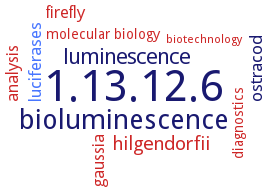1.13.12.6: Cypridina-luciferin 2-monooxygenase
This is an abbreviated version!
For detailed information about Cypridina-luciferin 2-monooxygenase, go to the full flat file.

Word Map on EC 1.13.12.6 
-
1.13.12.6
-
bioluminescence
-
luminescence
-
hilgendorfii
-
luciferases
-
ostracod
-
firefly
-
analysis
-
gaussia
-
diagnostics
-
molecular biology
-
biotechnology
- 1.13.12.6
-
bioluminescence
-
luminescence
- hilgendorfii
- luciferases
-
ostracod
- firefly
- analysis
- gaussia
- diagnostics
- molecular biology
- biotechnology
Reaction
Synonyms
Apogon luciferase, Apogon luciferase 1, CLase, CLuc, Cypridina luciferase, Cypridina luciferin 2-monooxygenase, Cypridina noctiluca luciferase, Cypridina-type luciferase, Fbp, FBP-IgG, luciferase (Cypridina luciferin), PGE2-luciferase, Vargula luciferase
ECTree
Advanced search results
Cloned
Cloned on EC 1.13.12.6 - Cypridina-luciferin 2-monooxygenase
Please wait a moment until all data is loaded. This message will disappear when all data is loaded.
expression of a chimeric protein G-luciferase enzyme in COS-1 and CHO cells
-
expression of human Delta-like protein (Dlk-1) antigen in HEK-293 cells, immunization of mice (BALB/c) with HEK293-Dlk-1 cells or with the expression vector that encodes full-length Dlk-1 cDNA
-
recombinant expression from vector p35SHSPG in Nicotiana benthamiana BY-2 cells, luciferase is efficiently secreted from cells with its native signal peptide, two potential N-glycosylation sites are modified with plant-type oligosaccharide chains. Recombinant expression of the enzyme in Arabidopsis thaliana roots in the cell wall of intact cells and the apoplast of plasmolyzed cells but not in the protoplasm. Cluc contains its own secretion signal peptide, which results in efficient secretion and folding of Cluc
recombinant expression of wild-type and mutant enzymes in COS-1 cells and in Pichia pastoris strain GS115
recombinant mutant enzyme lacking N-glycosylation motifs is produced using Expi293F cells, silkworms, and tobacco BY-2 cells. The relative activity of the produced Dmt CLucEX is almost the same as that of the wild-type CLucEX, whereas recombinant CLuc deficient in N-glycosylation binding sites (Dmt CLucCO) is approximately 20% of that of wild-type CLucCO. In the case of the silkworm system, the relative activity of mutant CLuc purified using only anti-FLAG affinity gel is 25% of that of wild-type CLucSW. However, further purification reveals that approximately 75% of the FLAG purified recombinant protein is aggregated and its enzyme activity is lost. In the BY-2 cells, attempt to express Dmt CLucBY result in no recombinant protein production despite the use of 4 independent transgenic callus clones. The productivity of CLuc mutated in the N-glycosylation sites differs depending on the expression host
Staphylococcus aureus ZZ-domain gene of protein A is amplified by PCR using pEZZ18 plasmid, the gene for Cypridina luciferase (obtained by PCR) is fused to the C-terminus of the ZZ-domain in the vector to give the expression vector pCold-ZZ-VL, the vector is then expressed in Escherichia coli BL21 grown in Luria-Bertani broth at 37°C
-


 results (
results ( results (
results ( top
top





